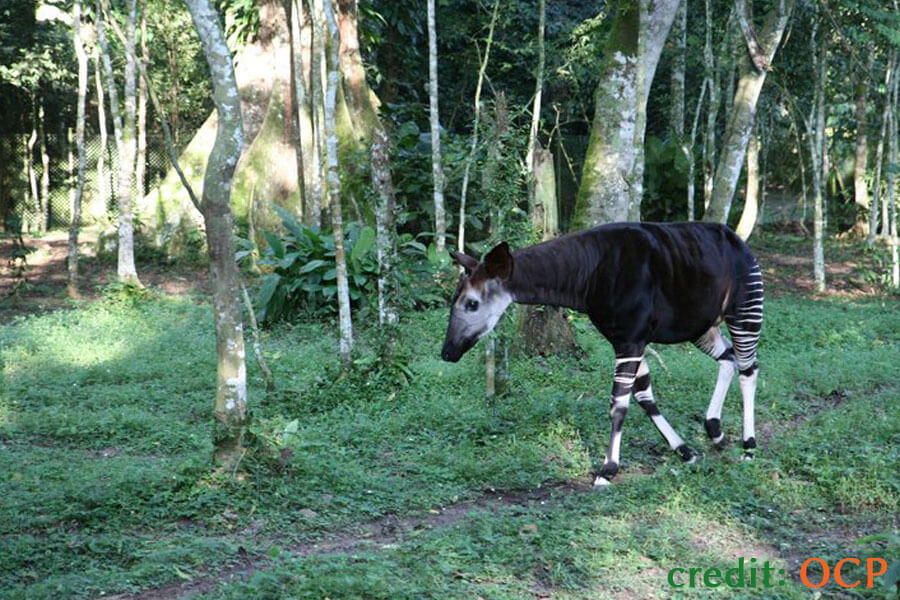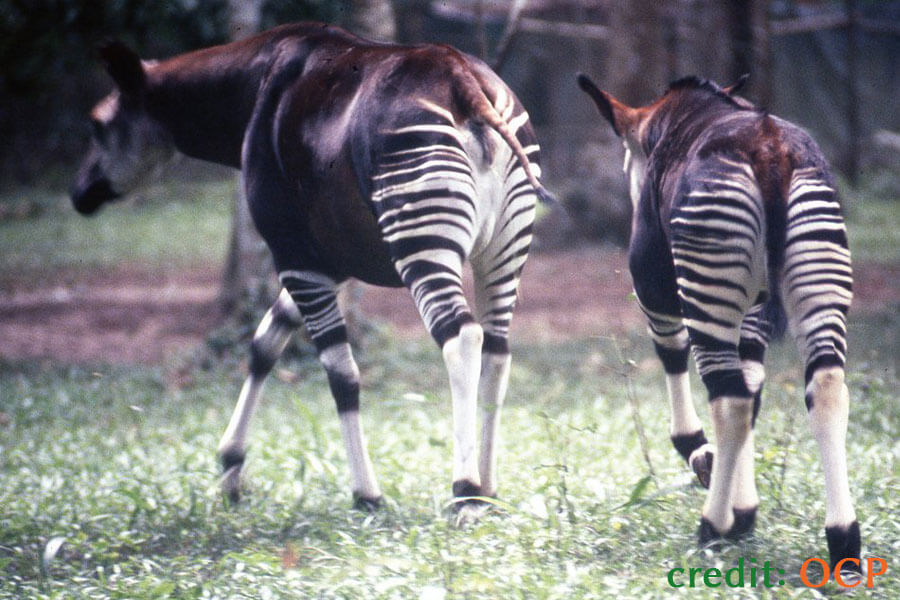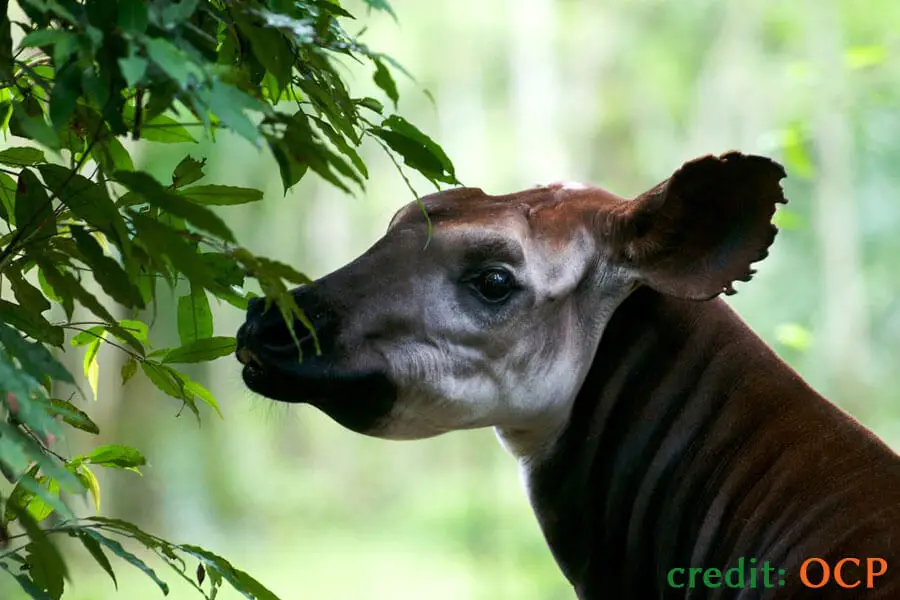Okapi is a remarkable animal that is native to the Central African rainforests of the Democratic Republic of Congo. The okapi is most notably known because of its distinctive appearance which makes them seem like a crossbreed between a zebra and a giraffe.
Okapis have stripes like zebras, and long necks like giraffes but live in the rainforests where the zebras and giraffes never live. In truth, they are only related to giraffes and have no connection to zebras.
From their unique physical features to their solitary and elusive nature, Okapis are full of interesting facts that are sure to captivate any nature lover. This article will take a closer look into the world of the okapi so that you can learn more about this "forest giraffe" - from its physical qualities to conservation initiatives.
Facts About Okapi
1. How Does The Okapi Look Like
The okapi looks like a cross between a zebra and a giraffe. It has a velvety chocolate-brown coat and white stripes on its legs resembling a zebra's hindquarters. On the other hand, it has a long neck and rounded body form that are more similar to a giraffe.
The okapi has a very long tongue, erect ears, and cloven hooves all of which are great adaptations for its rainforest natural habitat. Okapis are commonly nicknamed "forest giraffes" and while they are related, they are not the same species.

2. Is Okapi Half Zebra?
While the okapi's rump and legs have white stripes reminiscent of a zebra, it is not related to zebras. The okapi is the only relative of the giraffe and has many physical and behavioural adaptations that are closely related to the giraffe.
As with the zebra, the stripes on the okapi help it to easily blend into its environment and camouflage.
3. How Big Are Okapis
Okapis are large animals that typically measure 5 feet (150 cm) tall at the shoulder and can weigh more than 300 kilograms. Unlike most other animals, female okapis tend to be bigger than their male counterparts.
Female okapis often weigh from 225 to 350 kilograms (495 - 770 lbs) while male okapis weigh between 200 and 300 kilograms (440 - 660 lbs).

4. Where Do Okapis Live?
Okapis are native to central Africa's dense rainforests, notably the Democratic Republic of Congo. They are mostly found in the Ituri Forest, which is a very biodiverse environment with a broad array of animal and plant species.
Okapis are well-adapted to this habitat, navigating through the forest and avoiding predators with their strong senses and ability to move softly.
5. What Do Okapis Eat?
Okapis are herbivores, which means they solely eat plants. They usually graze on leaves, fruits, flowers, and fungus. Their long, flexible tongues and prehensile top lip enable them to reach high into trees for food.
Okapis have a unique digestive mechanism that allows them to easily break down difficult plants. They are also known to consume charcoal, which can aid in the neutralization of harmful toxins found in some plants.

6. How Long Is The Tongue
Okapis are known for their incredibly long tongues, which can measure up to 18 inches in length. The okapi utilizes the long tongue to reach the leaves and other vegetation on the branches of trees.
For some comparison, the tongue of a giraffe measures about 18 to 21 inches in length yet a human tongue is around 3 inches.
7. Are Okapis Social Animals?
Okapis are solitary animals that mostly come together for mating and reproduction. Except for a female which might be found with its young calf, okapis are often found alone.
In the wild, okapis are quite hard to see because they are very stealthy and quiet as they go through their forest habitat. The typical home range of the males is around 13 square kilometres because they move quite often as opposed to the females which utilize around 5 square kilometres.
Okapis can communicate with each other in many ways, mainly through vocalizations and body language such as inhaling through the mouth.

8. How Does Okapi Reproduce?
Okapis often mate during the dry season and give birth to a single calf after a pregnancy of 15 months. The newborn okapi calf weighs between 14 and 30 kilograms (31- 66 lbs).
The calf can stand on its own just 30 minutes after birth and can start taking solid food in 3 months. The newborn okapi calf doesn't defecate for the first month, and it is thought that this is to avoid predators, like leopards, that would easily follow the traces and get to the young calf.
Okapis have a lifespan of between 20 and 30 years. In the wild, they typically live for 20 years but can live up to 30 in the captive environment of a zoo or sanctuary where it is protected from the threats of the wild, especially predators.
Related article: Comparing the lifespan of African animals
9. How Fast Does Okapi Run
While you wouldn't expect big and tall animals that live in dense rainforests to run fast, Okapis are quite quick and can run at speeds of up to 60 kilometres per hour (37 miles per hour). This is very comparable to other African animals in the savannah that need the speed for either hunting or outrunning the predators.
For context, the okapi runs as fast as a giraffe and slightly slower than a zebra. And in mother nature's balance of things, the okapi runs just slightly faster than the leopard (58 km/h) which happens to be its main predator deep in the forest.
10. How Many Okapis Are Left
According to the International Union for the Conservation of Nature (IUCN), the Okapi is listed as endangered, with decreasing numbers. It is estimated that there are between 10000 and 15000 okapis left in the wild.
While Okapis can be found in some zoos and wildlife sanctuaries worldwide, their conservation in the wild is greatly hindered by the political unrest in the Democratic Republic of Congo which makes conservation work extremely challenging.
Related article: Africa's most endangered animals
11. What Threatens Okapi?
Okapis in the wild confront a wide variety of threats. Okapis die due to a variety of factors that include:
-
Habitat Loss
Deforestation and human encroachment are quickly destroying the okapi's habitat in the rainforests of Central Africa. The reduced habitat leads to shrinking food sources and dwelling areas, making survival more challenging.
-
Hunting
Okapis are hunted for their flesh, hide, and horns. They are also sought for traditional medicinal practices.
-
Diseases
Okapis, like other wildlife, are vulnerable to a variety of illnesses, including those transferred by other animals and people.
-
Poaching
Okapis are sometimes trapped in snares or traps set by poachers targeting other animals such as antelopes or elephants.
-
Climate Change.
Climate change can have a significant impact on the okapi's habitat and food supply, making survival more difficult. Any disruption in the ecosystem always has rippling effects on every animal and plant in the given habitat.
Ultimately, it is the combination of these factors that threatens the survival of the okapi in the wild.
12. Conservation Efforts For Okapi
The Okapi Conservation Project (OCP) in the Democratic Republic of the Congo is leading the charge to save the Okapi in the wild. This is accomplished through habitat protection, anti-poaching campaigns, education, and scientific research.
They also collaborate with local communities to develop sustainable livelihoods, such as beekeeping and conduct research to better understand the species' behaviour and environment.
Given the okapi's habitat in the deep woods of D.R. Congo, conservation efforts are being impeded by instability rather than aided by tourists. Wildlife zoos and sanctuaries also play a vital role in okapi conservation through breeding and research.
Conclusion
The okapi is a fascinating and rare mammal that is an important element of its forest habitat's ecology. The okapi is a species worth appreciating and safeguarding because of its remarkable look and intriguing activities.
We can help future generations see and appreciate the beauty and significance of this extraordinary "forest giraffe" by supporting conservation initiatives.
